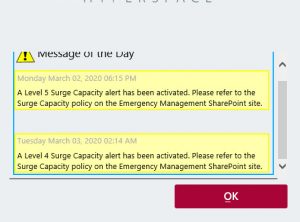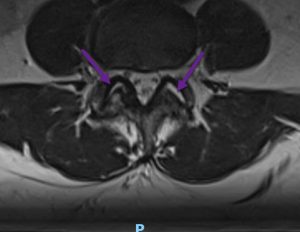COVID-19 May Be A Public Health Crisis…
...But Not For the Reason You Think


Allow me to begin today’s post with a brief story that I think will put things into perspective. I am both an employee and patient of my university’s hospital. My primary appointment (ie, job) is in the College of Liberal Arts and Sciences, but I also have affiliate appointments (ie, jobs) in our children’s hospital and cancer center. I frequently access our electronic medical records system to do my work and each and every day when I log in, I see the image on the left
These “Surge Capacity” alerts are shorthand for “Our hospital is full.” A Level 4 Surge Capacity is shorthand for “Oh shit, this place is full!!” and a Level 5 Surge Capacity is shorthand for…
 The levels provide guidance for how to deal with emergent patients, those needing advanced or immediate medical care, when the hospital is full. Our hospital is the major tertiary referral center for the state, meaning that we provide specialized care for very complicated patients. We are the major referral center for neonatology, organ transplant, bone marrow transplant and cancer, trauma, and more. We are always full. I’ve can’t remember ever logging in and not seeing our hospital at capacity.
The levels provide guidance for how to deal with emergent patients, those needing advanced or immediate medical care, when the hospital is full. Our hospital is the major tertiary referral center for the state, meaning that we provide specialized care for very complicated patients. We are the major referral center for neonatology, organ transplant, bone marrow transplant and cancer, trauma, and more. We are always full. I’ve can’t remember ever logging in and not seeing our hospital at capacity.

But, we also provide care to the people in our community. If you live in the surrounding community, work at the university, and are covered by the university’s insurance plan, there is a huge financial incentive to receive care in our health system. Seeking healthcare outside of our system can mean 20% or 40% co-insurance payments. At the same time, community and rural hospitals are closing because providing medical care is not financially sustainable, so our “community” continues to expand. So, we are both a tertiary care center and a community hospital. In my own recent experience with our health care system, I waited two weeks to even be triaged by a specialty clinic for painful arthritis in my back and hip (I warned you before, I am becoming an aged Isis). It took more than a month to be seen by a physician’s assistant. I’ve been told I need steroid injections in my back and hip. It’s now been two months since I first began the process. My hip still hurts, but I continue to wait for my turn for these injections. My situation isn’t life-threatening. It just makes me cranky at the end of the day at my desk.
What does that mean for the public? It means that we’ve got a Mary and Joseph problem. There’s no room at the inn and our health care system is precariously close to being overwhelmed. I’m not sure what we would do if we were hit with 100 new patients impacted by COVID-19 and needing hospitalization (0.003% of my state’s population). We are already being directed to conserve masks and gown (ie, personal protective equipment) because there is a shortage. We’re limiting data collection in certain units that require isolation precautions because our work is non-essential. Our current health care system is not prepared for the increased demands of a pandemic.
A compounding problem is that the government under the direction of our orange overlord is not providing information that is particularly helpful to community providers. Trump met with ten pharmaceutical executives yesterday at the White House, including the heads of Gilead, Johnson & Johnson, Pfizer, and Regeneron who he referred to as “geniuses.” He wanted to talk about work toward a vaccine. It’s a nice idea that will be ready for primetime on a timeline of months to years. It’s not a great strategy for right now when people are afraid and the system is overwhelmed. To be honest, supportive care is likely to be the best treatment and it won’t differ much from what’s done for influenza and other viruses. What we don’t know is how to prepare for the magnitude of the problem because we don’t know the magnitude of the problem. We don’t know the magnitude of the problem because the administration is not clearly defining guidelines for surveillance. Even if we knew the magnitude of the problem, we may not have the capacity.
The CDC has provided great guidance for testing for influenza in the community. What methods are acceptable? What kind of lab is appropriate? There are lists of FDA-cleared nucleic acid detection based tests and their manufacturers that pathology labs can use as a resource for surveillance. People are calling their doctor’s office and hospitals looking for COVID-19 test kits. These test kits are not freely available. The CDC’s website reads the following:
Updated February 28, 2020
Clinicians should immediately implement recommended infection prevention and control practices if a patient is suspected of having COVID-19. They should also notify infection control personnel at their healthcare facility and their state or local health department if a patient is classified as a PUI for COVID-19. State health departments that have identified a PUI or a laboratory-confirmed case should complete a PUI and Case Report form through the processes identified on CDC’s Coronavirus Disease 2019 website. State and local health departments can contact CDC’s Emergency Operations Center (EOC) at 770-488-7100 for assistance with obtaining, storing, and shipping appropriate specimens to CDC for testing, including after hours or on weekends or holidays. Currently, diagnostic testing for COVID-19 is being performed at state public health laboratories and CDC. Testing for other respiratory pathogens should not delay specimen testing for COVID-19.
This doesn’t mean that test kits are currently available at doctor’s offices and hospitals. It means that suspected cases are being tested at centralized laboratories and only in people that meet particular criteria – those in proximity to a known COVID-19 patient, those who have traveled to a region with confirmed COVID-19, and those at “elevated risk” are eligible for testing. There are reports that the number of test kits will increase to cover 0.3% of the U.S. population by the end of the week, but it’s not clear whether these will be released to the community for testing or whether testing will continue at centralized facilities.
How has this created the perfect storm of public fear? Hospitals are already overwhelmed by capacity. It’s cold and flu season so people have the sniffles. Is it a cold? Is it COVID-19? Why can’t I go to urgent care and just get swabbed like when I think I have strep or influenza? People are afraid, so they want to be tested. Our president isn’t allowing our nation’s experts to talk to the public to explain their plans to roll out surveillance, leaving people’s fears to compound. He’s hosting a season of The Apprentice with pharma executives to see who will create a vaccine first, leaving journalists to interpret the information vacuum and the CDC ‘s response as bungled and slow. It hasn’t been. The CDC has had successes and failings, but has turned around a surveillance kit in an admirable amount of time. Our president is not providing key information and reassurance to the public, likely because he doesn’t understand the process. He’s only worried about the optics and the public can tell that the emperor has no clothes. When people are afraid, they seek out resources at their local hospitals. See above where I describe how overwhelmed our system already is.
This should be a lesson that our current infrastructure is severely burdened. Space and personnel. Our current model is not sustainable. Our health care infrastructure is no different than our highways and bridges. If it collapses, it brings our economy to a halt.
The current COVID-19 situation should be a signal that we need to revamp funding to the biomedical enterprise so that we can be more proactive and less reactive when unpredictable new health challenges arise. If waiting a couple of weeks for the ability to test for a new pathogen isn’t palatable, then we should be investing in preparedness and biomedical research.
The missing component in this response is an administration that listens carefully and learns. This should all be a lesson that we need a leader than communicates honestly and thoughtfully with the public. Who learns from experts, and surrounds themself with wisdom, so that they can reassure the public when necessary and call the public to action when necessary.
In the meantime, if you’re worried about how COVID-19 will impact you, consider the CDC’s advice. They’re not much different than guidelines for the flu.
Stay home if you’re sick. Wash your hands frequently with soap and water. Try to avoid touching your mucus membranes (eyes, nose and mouth). Cover your nose and mouth with a tissue if you sneeze and throw the tissue in the trash. Don’t wear a facemask to protect yourself, but consider one if you have respiratory symptoms in order to prevent transmitting viruses to others. Limit travel to places where COVID-19 is endemic.
And an additional recommendation from yours truly – your friendly neighborhood science professor with the fucked up back and hip. Elect a president in 2020 that takes advice from experts and doesn’t silence them because he’s worried about how it will poll. Elect a president that will provide reassurance when it’s helpful, or a call to action when it’s helpful, and will communicate truthfully about the state of things.
Elect a president that is going to think carefully about how burdened the current healthcare system is before the straw breaks the camel’s back.





This is a really helpful overview. I am not in the US, but we also have hospitals with long wait times and a provincial premier who just cut healthcare funding (to force the health service to be more efficient is what his lackeys are telling us). Dr Google telling people there are tests for everything and then hooking us up with links to charlatans is not going to help.
Thank you! I’m glad you felt it helpful!